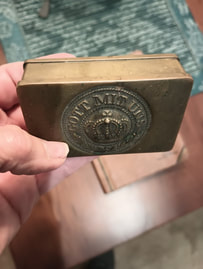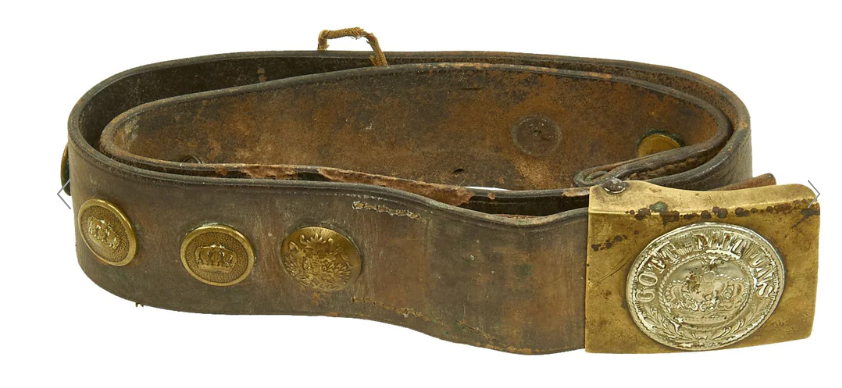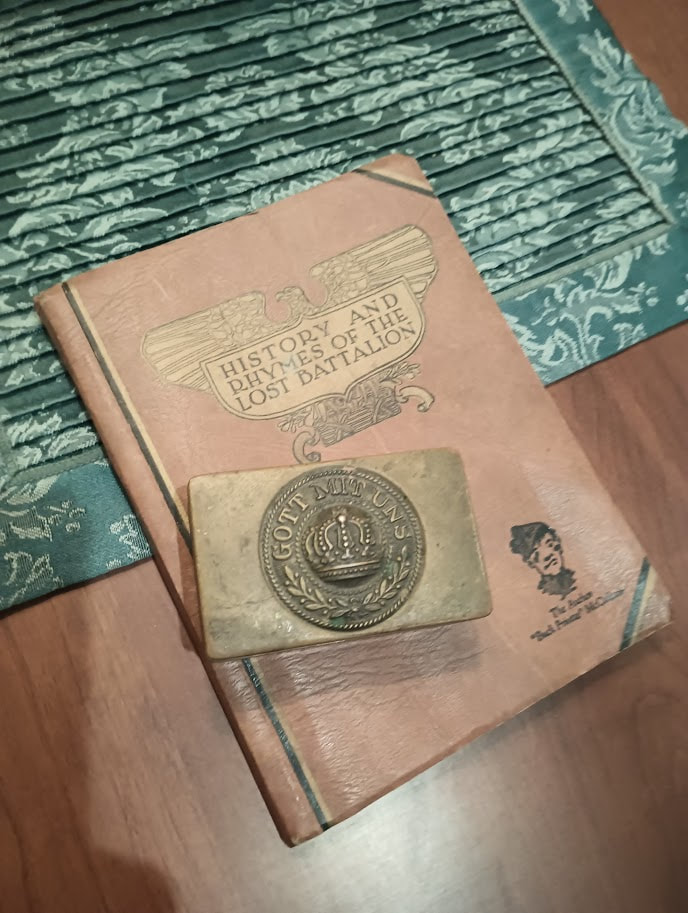One of my sisters really gets me. I mean, really, really understands what interests and excites me. Luckily for me, she also loves to search ebay for unique things.
This past Christmas, I got two treasures from her that will undoubtably work their way into one of my novels. I’m sharing them with you and hope that they interest and excite you as much as they did me.
This past Christmas, I got two treasures from her that will undoubtably work their way into one of my novels. I’m sharing them with you and hope that they interest and excite you as much as they did me.
The first gift was a little brass box with an emblem that read “Gott Mit Uns” over a picture of a crown. After a little research, I discovered that Gott Mit Uns is German for God with us, and was a slogan used by the German army in World War I. The crown is the imperial crown of the Second Reich, and is described both as German and as Prussian online. The emblem on the box originally graced a belt buckle on a uniform. Here is a picture of one still attached. |
So how did this emblem get placed on a brass box? The answer is an interesting bit of World War I history. Most people know that World War I is notable as the war in which both sides hunkered down in trenches along a front that became unmovable. Soldiers spent many weary months hunkered down in the mud, waiting to go “over the top” and attack the other side. The waiting grew monotonous. To counter the boredom, soldiers found things to do to occupy their time. They had to use what they had at hand, and once one creative soldier had invented a form of art, it seems all his buddies copied it. The thousands of examples of vases made from shell casings, each unique in its decorations, attests to the hundreds of thousands of shells that flew over the trenches. |
Sometimes what was lying around was pieces of uniforms. The belt buckle on a German uniform is exactly the right size to be made into a match box. The one I have has a lid that separates from the box. Others I found online were hinged or were squared off tubes with open ends. On some, the smooth brass had been deckled or worked into ridges. I do not know if the top of the box is part of the original belt buckle or if it was fashioned from a fragment of a shell casing. Either way, I can imagine a soldier hunkered down in the cold and damp, intently working on a bit he picked up in no man’s land to turn it into a little trinket for his loved ones back home.
The second treasure my sister gave me is a little, paperback book entitled History and Rhymes of the Lost Battalion, by “Buck Private” McCollum. Lee Charles McCollum self-published a 32-page volume of poetry by that name in 1919. That edition included sketches by Franklin Sly, another veteran of the American Expeditionary Force that went to Europe in 1918. Pt. McCollum saw action in France in many of the same areas as the famous Lost Battalion, but he is not listed on the unit's roster. Whether that means he wrote under a nom de plume was something I was not able to ascertain. The books was again published in 1919, 1921, 1922, and 1929, by which time Franklin Sly had passed away and another veteran, and Tolman R. Reamer, had completed artwork. The little volume grew over time. By 1939 it was up to 140 pages and included stories, remembrances by some of the key figures in the fight, pictures and tributes both to the Battalion and to its commander, Lt. Col. Charles Whittlesey, who had passed away in 1921. Over 700,000 copies of the various editions were sold.
The volume tells the story of Battalion 1 of the 77th Division, which pushed hard into the Argonne Forest and found itself cut off from the rest of the American forces.
On the morning of October 3, 1918, Companies A, B, C, E, and H of the 808th Infantry, the 308th Infantry’s Company H, Company K of the 307th Infantry and Companies C and of 306th Machine Gun Battalion, all members of the Seventy-Seventh Division, were cut off from the other American forces near Charlevoix, in the Argonne Forest, and surrounded by a superior number of Germans. For four days, the approximately 550 men, under command of Major Charles W. Whittlesey managed to survive without food and with a dwindling supply of ammunition, fending off enemy machine gun, rifle, trench mortar, and grenade fire and some friendly fire from their own artillery. When they were finally reconnected with the main American force, only 194 of the officers and men were able to walk out of the position. 107 had been killed.
McCollum’s poems are about that experience, plus other observations in war, including poems about his gas mask and about kissing a French girl. Some are cute and sweet, while others are sad elegies to friends now dead. It’s a great volume for anyone interested in the experience of American doughboys.
I’m thinking I need to write a sequel to my WWI novel, a Blaze of Poppies, with a character who was in the Lost Battalion and now carries around a matchbox as a memento.
What do you think? Is that a story you'd like to read? If I ever write it, you can thank my sister.
On the morning of October 3, 1918, Companies A, B, C, E, and H of the 808th Infantry, the 308th Infantry’s Company H, Company K of the 307th Infantry and Companies C and of 306th Machine Gun Battalion, all members of the Seventy-Seventh Division, were cut off from the other American forces near Charlevoix, in the Argonne Forest, and surrounded by a superior number of Germans. For four days, the approximately 550 men, under command of Major Charles W. Whittlesey managed to survive without food and with a dwindling supply of ammunition, fending off enemy machine gun, rifle, trench mortar, and grenade fire and some friendly fire from their own artillery. When they were finally reconnected with the main American force, only 194 of the officers and men were able to walk out of the position. 107 had been killed.
McCollum’s poems are about that experience, plus other observations in war, including poems about his gas mask and about kissing a French girl. Some are cute and sweet, while others are sad elegies to friends now dead. It’s a great volume for anyone interested in the experience of American doughboys.
I’m thinking I need to write a sequel to my WWI novel, a Blaze of Poppies, with a character who was in the Lost Battalion and now carries around a matchbox as a memento.
What do you think? Is that a story you'd like to read? If I ever write it, you can thank my sister.

A Blaze of Poppies is an historical novel that tells the story of a New Mexico rancher in the southern part of the state and a member of the New Mexico National Guard's Battery A, who participated in many of the final battles of World War I. It is available in paperback and ebook through many online booksellers and directly from the author.









No comments:
Post a Comment